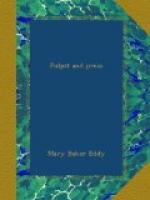[New York Tribune, February 7, 1895]
[Extract]
Boston has just dedicated the first church of the Christian Scientists, in commemoration of the Founder of that sect, the Rev. Mary Baker Eddy, drawing together six thousand people to participate in the ceremonies, showing that belief in that curious creed is not confined to its original apostles and promulgators, but that it has penetrated what is called the New England mind to an unlooked-for extent. In inviting the Eastern churches and the Anglican fold to unity with Rome, the Holy Father should not overlook the Boston sect of Christian Scientists, which is rather small and new, to be sure, but is undoubtedly an interesting faith and may have a future before it, whatever attitude Rome may assume toward it.
* * * * *
[Journal, Kansas City, Mo., January 10, 1895]
[Extract]
GROWTH OF A FAITH
Attention is directed to the progress which has been made by what is called Christian Science by the dedication at Boston of “The First Church of Christ, Scientist.” It is a most beautiful structure of gray granite, and its builders call it their “prayer in stone,” which suggests to recollection the story of the cathedral of Amiens, whose architectural construction and arrangement of statuary and paintings made it to be called the Bible of that city. The Frankish church was reared upon the spot where, in pagan times, one bitter winter day, a Roman soldier parted his mantle with his sword and gave half of the garment to a naked beggar; and so was memorialized in art and stone what was called the divine spirit of giving, whose unbelieving exemplar afterward became a saint. The Boston church similarly expresses the faith of those who believe in what they term the divine art of healing, which, to their minds, exists as much to-day as it did when Christ healed the sick.
The first church organization of this faith was founded fifteen years ago with a membership of only twenty-six, and since then the number of believers has grown with remarkable rapidity, until now there are societies in every part of the country. This growth, it is said, proceeds more from the graveyards than from conversions from other churches, for most of those who embrace the faith claim to have been rescued from death miraculously under the injunction to “heal the sick, cleanse the lepers, raise the dead, cast out demons.” They hold with strict fidelity to what they conceive to be the literal teachings of the Bible as expressed in its poetical and highly figurative language.
Altogether the belief and service are well suited to satisfy a taste for the mystical which, along many lines, has shown an uncommon development in this country during the last decade, and which is largely Oriental in its choice. Such a rapid departure from long respected views as is marked by the dedication of this church, and others of kindred meaning, may reasonably excite wonder as to how radical is to be this encroachment upon prevailing faiths, and whether some of the pre-Christian ideas of the Asiatics are eventually to supplant those in company with which our civilization has developed.




